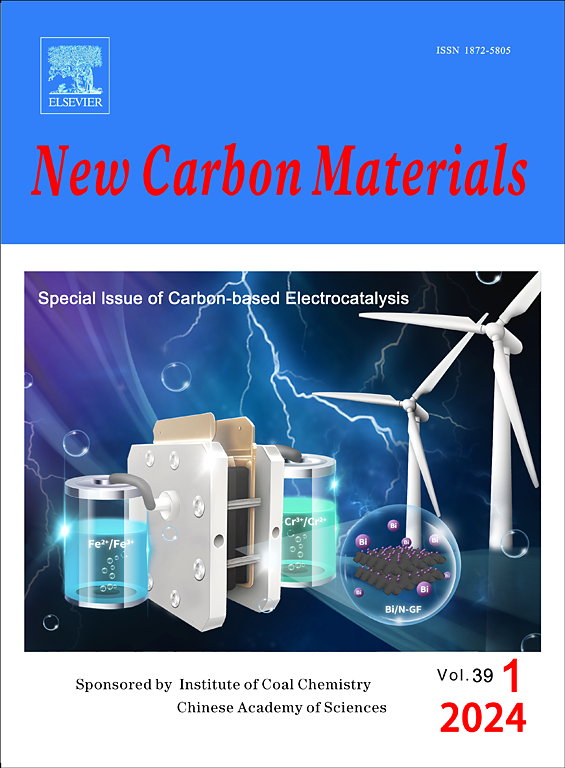金属有机框架及其衍生物在锂离子电容器中的应用
IF 5.7
3区 材料科学
Q2 Materials Science
引用次数: 0
摘要
为满足持续增长的储能需求,迫切需要同时具有高能量和高功率密度的锂离子电容器(LIC)。锂离子电容器有效地平衡了传统充电电池的高能量密度与超级电容器(SC)的高功率密度和长寿命。然而,阴极和阳极之间有限的动力学过程和容量不匹配仍然阻碍着 LIC 的发展。金属有机框架(MOFs)及其衍生物因其广泛的比表面积、不同的孔结构和拓扑结构以及可定制的功能位点而备受关注,成为实现高性能 LICs 的理想候选材料。MOF 衍生碳以其优异的电子导电性和大表面积而著称,可提供更好的电荷存储和快速离子传输。MOF 衍生的过渡金属氧化物有助于提高比容量和电化学稳定性。此外,MOF 衍生的金属化合物/碳氢化合物还能提供增强电容反应和法拉第反应的综合效应,从而实现卓越的整体性能。综述首先概述了 LIC 的基本原理,然后探讨了基于 MOF 的复合材料的合成策略和配体选择。然后分析了原始 MOF 及其衍生材料(如碳材料和金属化合物)在提高 LIC 性能方面的优势。最后,综述讨论了 MOFs 及其衍生物在 LIC 应用中面临的主要挑战,并提出了未来的研究方向和建议。本文章由计算机程序翻译,如有差异,请以英文原文为准。
The application of metal–organic frameworks and their derivatives for lithium-ion capacitors
There is an urgent need for lithium-ion capacitors (LICs) that have both high energy and high power densities to meet the continuously growing energy storage demands. LICs effectively balance the high energy density of traditional rechargeable batteries with the superior power density and long life of supercapacitors (SCs). Nevertheless, the development of LICs is still hampered by limited kinetic processes and capacity mismatch between the cathode and anode. Metal-organic frameworks (MOFs) and their derivatives have received significant attention because of their extensive specific surface area, different pore structures and topologies, and customizable functional sites, making them compelling candidate materials for achieving high-performance LICs. MOF-derived carbons, known for their exceptional electronic conductivity and large surface area, provide improved charge storage and rapid ion transport. MOF-derived transition metal oxides contribute to high specific capacities and improved electrochemical stability. Additionally, MOF-derived metal compounds/carbons provide combined effects that increase both the capacitive and Faradaic reactions, leading to a superior overall performance. The review begins with an overview of the fundamental principles of LICs, followed by an exploration of synthesis strategies and ligand selection for MOF-based composite materials. It then analyzes the advantages of original MOFs and their derived materials, such as carbon materials and metal compounds, in enhancing LIC performance. Finally, the review discusses the major challenges faced by MOFs and their derivatives in LIC applications and offers future research directions and recommendations.
求助全文
通过发布文献求助,成功后即可免费获取论文全文。
去求助
来源期刊

New Carbon Materials
MATERIALS SCIENCE, MULTIDISCIPLINARY-
CiteScore
6.10
自引率
8.80%
发文量
3245
审稿时长
5.5 months
期刊介绍:
New Carbon Materials is a scholarly journal that publishes original research papers focusing on the physics, chemistry, and technology of organic substances that serve as precursors for creating carbonaceous solids with aromatic or tetrahedral bonding. The scope of materials covered by the journal extends from diamond and graphite to a variety of forms including chars, semicokes, mesophase substances, carbons, carbon fibers, carbynes, fullerenes, and carbon nanotubes. The journal's objective is to showcase the latest research findings and advancements in the areas of formation, structure, properties, behaviors, and technological applications of carbon materials. Additionally, the journal includes papers on the secondary production of new carbon and composite materials, such as carbon-carbon composites, derived from the aforementioned carbons. Research papers on organic substances will be considered for publication only if they have a direct relevance to the resulting carbon materials.
 求助内容:
求助内容: 应助结果提醒方式:
应助结果提醒方式:


